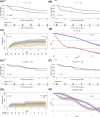Sinonasal B-cell lymphomas: A nationwide cohort study, with an emphasis on the prognosis and the recurrence pattern of primary diffuse large B-cell lymphoma
- PMID: 35104916
- PMCID: PMC9303446
- DOI: 10.1002/hon.2968
Sinonasal B-cell lymphomas: A nationwide cohort study, with an emphasis on the prognosis and the recurrence pattern of primary diffuse large B-cell lymphoma
Abstract
Lymphomas of the nasal cavity and paranasal sinuses (NPS) are rare. Knowledge on sinonasal B-cell lymphoma (SNBCL) primarily comes from case series or single-center studies on small cohorts. We sought to determine the subtype distribution, clinical characteristics, disease behavior, and prognosis on a nationwide scale, with an emphasis on prognostic factors for the most common sinonasal lymphoma, primary sinonasal diffuse large B-cell lymphoma (PSDLBCL). We collated all data from medical records and national databases on patients registered with SNBCL from 1980 through 2018 in the national pathology registry and collected all tissue samples for validation of diagnosis. We included 205 patients and found 10 different subtypes of lymphoma. Diffuse large B-cell lymphoma (DLBCL) was the predominant subtype (80%). The incidence of SNBCL was 0.14/100,000 person-years. The five-year progression-free survival (PFS) and overall survival rates for PSDLBCL were 50% and 56%, respectively. For PSDLBCL, Rituximab showed a statistically significant effect (Hazard Ratio 0.22, p < 0.001), whereas consolidative radiotherapy combined with immunochemotherapy was of limited value (PFS, p = 0.93). When treatment failure occurred, DLBCL showed a distinct pattern of recurrence/dissemination to the NPS, skin, breast, central nervous system (CNS), and/or testis. Collectively, DLBCL comprised a clear majority of SNBCLs, although nine other subtypes were represented. Data showed that immunochemotherapy increased survival for PSDLBCL and that the addition of radiotherapy did not benefit patients. Furthermore, treatment failure for sinonasal DLBCL showed a possible common pathogenesis with primary extranodal lymphomas of specific locations (e.g., CNS, skin, breast, and testis).
Keywords: lymphoma; nose neoplasms; paranasal neoplasms; prognosis; treatment.
© 2022 The Authors. Hematological Oncology published by John Wiley & Sons Ltd.
Conflict of interest statement
The authors declare that the research was conducted in the absence of any commercial or financial relationships that could be construed as potential conflicts of interest.
Figures


References
-
- Harbo G, Grau C, Bundgaard T, et al. Cancer of the nasal cavity and paranasal sinuses: a clinico‐pathological study of 277 patients. Acta Oncol. 1997. Jan 1;36(1):45‐50. - PubMed
-
- Proulx GM, Caudra‐Garcia I, Ferry J, et al. Lymphoma of the nasal cavity and paranasal sinuses: treatment and outcome of early‐stage disease. Am J Clin Oncol. 2003 Feb;26(1):6‐11. - PubMed
-
- Abbondanzo SL, Wenig BM. Non‐Hodgkin’s lymphoma of the sinonasal tract. A clinicopathologic and immunophenotypic study of 120 cases. Cancer. 1995. Mar 15;75(6):1281‐1291. - PubMed
-
- Azarpira N, Ashraf M, Monabati A, et al. Primary lymphoma of nasal cavity and paranasal sinuses. Lab Med. 2012. Nov 9;43:294‐299.
-
- Cuadra‐Garcia I, Proulx GM, Wu CL, et al. Sinonasal lymphoma: a clinicopathologic analysis of 58 cases from the Massachusetts general Hospital. Am J Surg Pathol. 1999;23(11). [Internet]Available from: https://journals.lww.com/ajsp/Fulltext/1999/11000/Sinonasal_Lymphoma__A_... - PubMed
MeSH terms
Substances
Grants and funding
LinkOut - more resources
Full Text Sources

